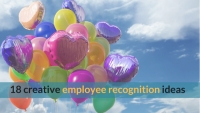
Corporate Culture Articles
Creating an atmosphere of excellence and purpose takes time and patience. So does building a support system that favors employees and allows them to do their best every day.
One of the more rewarding aspects of internal employee communication is when communicators are called upon to rally the troops for volunteer activities in the name of corporate social responsibility. Cleaning out local parks, stocking supplies at a food pantry, serving meals at a homeless shelter, or any of the hundreds of other ways companies can pitch in to make a difference in their community.
The whole point of business is to grow, to increase market share and margins, to start generating profits and increasing pay for the employees while keeping them onboard with superior employee video communications. But growth isn't a straightforward proposition. The pace and management of growth is just as important. Grow too fast (Krispy Kreme comes to mind), and you may misconstrue the market situation. Grow too slowly (Dell Computers), and the opposition overtakes you.
Every employer knows how difficult it is to make the best of talent stick. In fact, new joiners are quite likely to quit their jobs within the first few months, says a research by Bamboo HR.
There’s an old saying in the military that every battle plan, no matter how clever, gets torn up as soon as the fighting starts. The same sometimes goes for the best-laid plans in change management.
Business leaders have come to accept that workforce analytics and planning are important to internal communications and the future success of their companies. At the same time however, those who believe their companies are good at it are a small minority. Most C-suite executives acknowledge an execution gap between what workforce analytics can do for them and what they currently get from analytics and planning.
A team leader in any organization must not only get the message of management across to all team members, he or she has to foster better employee engagement, communication, and collaboration. In complex working environments with remote workers and cross-functional team members, team leaders can get better results from employee collaboration by following these basic principles.
How do you incorporate social media into your business model? Some veteran companies may not be sure how to answer that question, if they can answer at all; this is where millennials come into play.
Today’s workplace is experiencing a shift from employee recognition as being “nice to have” to “need to have.”
An example of how a company completed its corporate culture change management mission effectively and efficiently.
With an overarching goal of employee engagement, the City of Memphis is set to launch a new benefit to help city workers who are burdened by student loans–the Student Loan Reduction Program. Dedicated to building and retaining an engaged workforce, Memphis is the first major U.S. city to offer such a benefit.
They sound like a good idea, but everyone who works in an open office hates open offices.
It doesn’t take a genius or a Harvard psychology study to know that high employee compensation makes for happier employees. It’s like studying the effect of mutually beneficial relationships on our overall happiness. Small businesses are often faced with a choice to provide their employees with top compensation packages from the start, or relying on more employees working for lower wages. Given enough time, companies with higher compensation packages are more successful.
While your main goal is to make a profit in business, you should never forget the workers who made those profits happen. Keep them engaged and motivated and you will not only improve retention but will make your company an even bigger success because the people behind the scenes feel like a valued part of the team.
As a ‘seasoned’ corporate communicator (i.e., one who got his start before Dave Grohl was in that band before the Foo Fighters), I’ve long felt one of the toughest employee communication issues I faced were when internal clients were overly-eager to share information.
American author Robert Lee Fulghum is best known for a book he created entitled All I Really Need to Know I Learned in Kindergarten. The book’s title is from the first essay and poem in the volume, which was published in 1986. The author lists the lessons normally learned in American kindergarten classrooms, and he reflects upon how the world would be improved if adults adhered to the same basic rules as children. Those rules? They include listening, sharing and living a life that balances work and play. We’re now seeing those principles in employee communications systems and HR training
Human Resources managers have to manage compliance at all levels of an organization, including adherence to fair labor and employment practices. One way Human Resources departments get into trouble with compliance is when they are faced with age discrimination claims
Millennials are taking over workplaces all over the world. Here's how you can create better employee engagement in an office full of Millennials, according to a Millennial.
Employee engagement is emerging as a critical element that can help differentiate organizations that offer world class service and those that don’t. Here’s why.
When it comes to business communications and change management, it's axiomatic that you need buy-in from the C-suite executives of your company. Regardless of what you need to achieve, it's simply easier if you have them in your corner.
Retention costs the company much less in terms of productivity and the process of finding and hiring new talent. The higher the employee turnover, the faster any organization can fall into oblivion. What causes high turnover and how can you limit it?






















